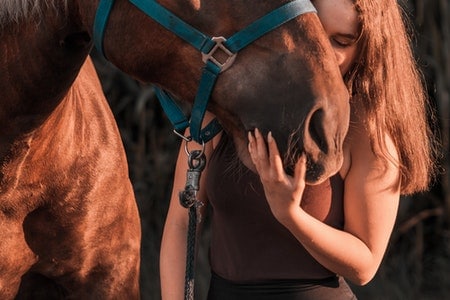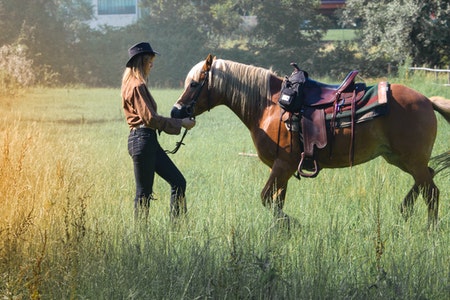Horse lice are a common problem for horse owners. These irritating insects can be found on the horse’s head, neck, and chest area. They feed off of blood from the horse and will cause hair loss in these areas if left untreated. Horse lice eggs (nits) are white or tan clumps that stick to the hairs near where you find live lice. A thorough inspection is needed to determine whether or not your horse has been infected with this nasty pest!
Have you ever had to deal with lice infestation on your horse before? It is not an enjoyable experience. Horses can become stuck in a never-ending cycle of reinfestation because they share their combs and brushes with other horses, as well as bedding, straws, or hay which may harbor the little insects. This often happens when one animal has been infected by another through contact – like if Romeo got them from Ramen and Rambo who both have long forelocks that easily house these parasites!
I did my best to get rid of this problem very quickly using natural herbal remedies made specifically for this issue. I also manually removed any remaining ones so that I could get back out onto those trails again soon enough without worrying about bringing more niggly pests home.
The best way to get rid of lice is by using a lice zapper comb like the RobiComb because it’s much faster and easier than nit-combing. I tried both methods, but as soon as I was done with manual nit combs I switched over to the RobiComb Zapper Comb for all remaining treatments.

This natural horse lice remedy should be top of mind for most riders, with the current rise in resistance to pesticides.
Step 1 – Nit Comb the Live Lice
When combing out lice and eggs, it’s important to know which methods are best for different situations. For instance, if you’re using the RobiComb electric zapper in place of a steel nit comb with olive oil or hair conditioner as an additive beforehand to make sliding easier (not necessary), then this article will be helpful!
You have two options when removing lice and eggs from your hair. You can either manually nit comb it or electrocute them as you comb them out using a RobiComb electric zapper, which doesn’t require any oil or conditioner before use.
If you choose to go with traditional steel nit combs, then olive oil may be an option for loosening up strands while sliding the metal along in order to get rid of those pesky bugs!
Using a Nit Comb
A stainless steel nit comb with tight grooves is the best way to find and remove those pesky lice. You can use an oil or conditioner if you need it, but make sure not to waste your time on plastic ones!
Combing lice out of hair is a time-consuming process. If you are manually nit combing, then it can be tempting to use mineral oil or silicone conditioning treatments instead of human hair conditioner because they coat the strands more easily and don’t leave your hand feeling sticky with leftover product from previous applications.
It is worth noting that these oils cannot penetrate down deep (where live lice feed) so there’s no way for them to kill off any eggs that might have been left behind due to missed nits in earlier parts of the strand being addressed by manual treatment methods.
One thing I like about RobiComb over steel nit combs is its ability not only to remove all visible adult lice but also to find those hidden larval cases.
It takes a lot of patience to comb through the hair, but it is worth the time and effort. If you have steel nit combs that are snagging on eggs as they pass out from your horse’s mane or tail, add more lubrication such as olive oil or conditioner so that any other hairs caught in between will slide right off with ease.
The steel nit comb will get full of eggs, so wipe it off on a paper towel.
Live louse’s life span is about 1 – 3 days if left untreated or 3 hours with treatment; make sure you read instructions carefully before starting the process!
The most important thing when applying this treatment to keep lice away from horses by keeping them away from hay and grass where they can jump onto another host within minutes!
Lice can be a difficult and time-consuming problem to deal with. After you’ve applied the remedy discussed, which is designed specifically for killing lice eggs (nits), nymphs, and adults as well as their eggshell casings; then combing the mane over piles of hay will take less effort than it would have before treatment was used.
Step 2 – Getting rid of Horse Lice Naturally?
Live lice are not only a nuisance but also can be extremely difficult to get rid of. These pests feed on blood and when they leave their host, they must find another one to survive. While there is no live louse cure available yet, going natural and using some of these remedies will help you to kill live lice off more efficiently!
Using Vinegar
First, preheat a pot of water to boiling. Next mix 1 part vinegar with 3 parts of very hot or steaming water and allow it to cool down before applying the mixture on your horse’s mane, tailhead area (including forelock), neckline, and backside in order for them not to get drenched from this procedure.
It is best that you apply the remedy during warmer months when lice are more active due to their increased blood flow which makes these pests easier to find and kill.
The key thing here is not letting any part of your horse go untreated so you don’t miss out on any.
Using Essential Oils
To make a lice treatment, mix together 1/4 cup olive oil and 3 dropperfuls of wild oregano. Add in one teaspoon tea tree essential oil if you have the kind available to avoid using commercial brands that have been diluted.
If not adding it or other oils, do 6 droppers worth instead (30 drops per dropper). Mix well before applying on horse’s head with two-inch sections at a time; don’t miss their mane because they like to hide there!

This recipe will cover an average-sized pony almost twice over so double it for larger horses or more than 2 cases at once.
This is a strong formula. If you have any contact with eyes or near the nostrils, mouth, udder or other mucous membranes then wash immediately and thoroughly to avoid serious consequences!
This essential oil remedy will kill the adults and nymphs (youngsters) of lice. To use, saturate roots of mane or forelock with spray before working it along hair’s length using fingers to distribute evenly. Remember that these parasites feed on blood in the skin so cover as much skin surface area possible for best results!
This report from Iowa State University indicates that insecticides do not kill lice eggs. It’s unclear whether the formula would be able to either, but there are other studies that show this product could work against adult lice.
There have been some clinical trials with wild oregano and it has shown success in killing yeast, bacteria, viruses, and even parasites in humans – no mention of its effect on ticks though. As a precautionary measure best stick with pyrethrin or piperonyl butoxide products instead until more research can confirm effectiveness for all use cases.
Lice are the bane of any horse owner’s existence.
I’ve had to deal with lice before and I don’t want it happening again. The last time, they were all over my horse so bad that he was itching himself until his skin got bloody from where the bites left scars. It took me a week for just one treatment!
It can be a tedious and sometimes frustrating task to get rid of these pests that invade body hair, feed on blood, and cause irritation.
When you find an infestation of louse eggs or live ones on your horse’s coat, use these two remedies in sequence to avoid any more trouble than necessary- first steel combing them off, then applying essential oil remedy (which should be applied every day).
You need not do anything else; it won’t take long at all because most people get their horses clear within 7 days.
Thankfully there is now an effective remedy applied topically which will eventually kill off all live eggs in the skin within days – all without having to shave down your horse first or take drastic measures such as toxic chemicals (which we never recommend).
So don’t let yourself fall into this same trap by knowing how best to deal with a head full of parasites before it becomes too late.
When caring for your horse, you may need to bag up all of their grooming tools and items that they use on a frequent basis. This includes combs, brushes, fly masks, or any other gear used frequently by the animal.
The easiest way is to seal them tightly in a ziplock style bag and put it away for at least one week before using again so as not to introduce lice back into the environment when being reintroduced into contact with another living creature’s hair while taking care of their needs.
Remember, lice can’t live for more than three days off the blood host. To avoid being an unfortunate victim of this pesky pest, make sure you’re regularly disinfecting your comb and brush with alcohol (or bleach). And be careful to keep all other horse gear that comes in contact with their skin completely clean as well!

